Apr.2024-Present l Huawei Research UK
I am a Principal Performance Modelling Engineer in Huawei Research (UK), focusing on modelling and simulation of upcoming CPU and NPU processors with AI future use-cases, leading architectural studies and software/hardware co-optimization to define requirements and new innovative features of such advanced processors.
Previous Experience
Jan.2024-Mar.2024 l Freelance AI Consultant
Exploring next career steps and AI freelance consulting.
Apr.2022-Dec.2023 l Samsung Research UK
Between 2022-2023, as Tech Lead and Principal Engineer in Samsung Research (SRUK), I worked with Chris Alder and Ben Duckworth, leading an On-Device AI Applied Research team and collaborated with cross-functional local and remote teams, driving on-device AI vision & speech applied research projects. Focusing on ML-hardware aware solutions: frameworks and neural network models optimisation for the next generation of Samsung products, from proof-of-concepts to commercial products in fast-paced projects.
• Speech Separation and Enhancement (2022-2023)
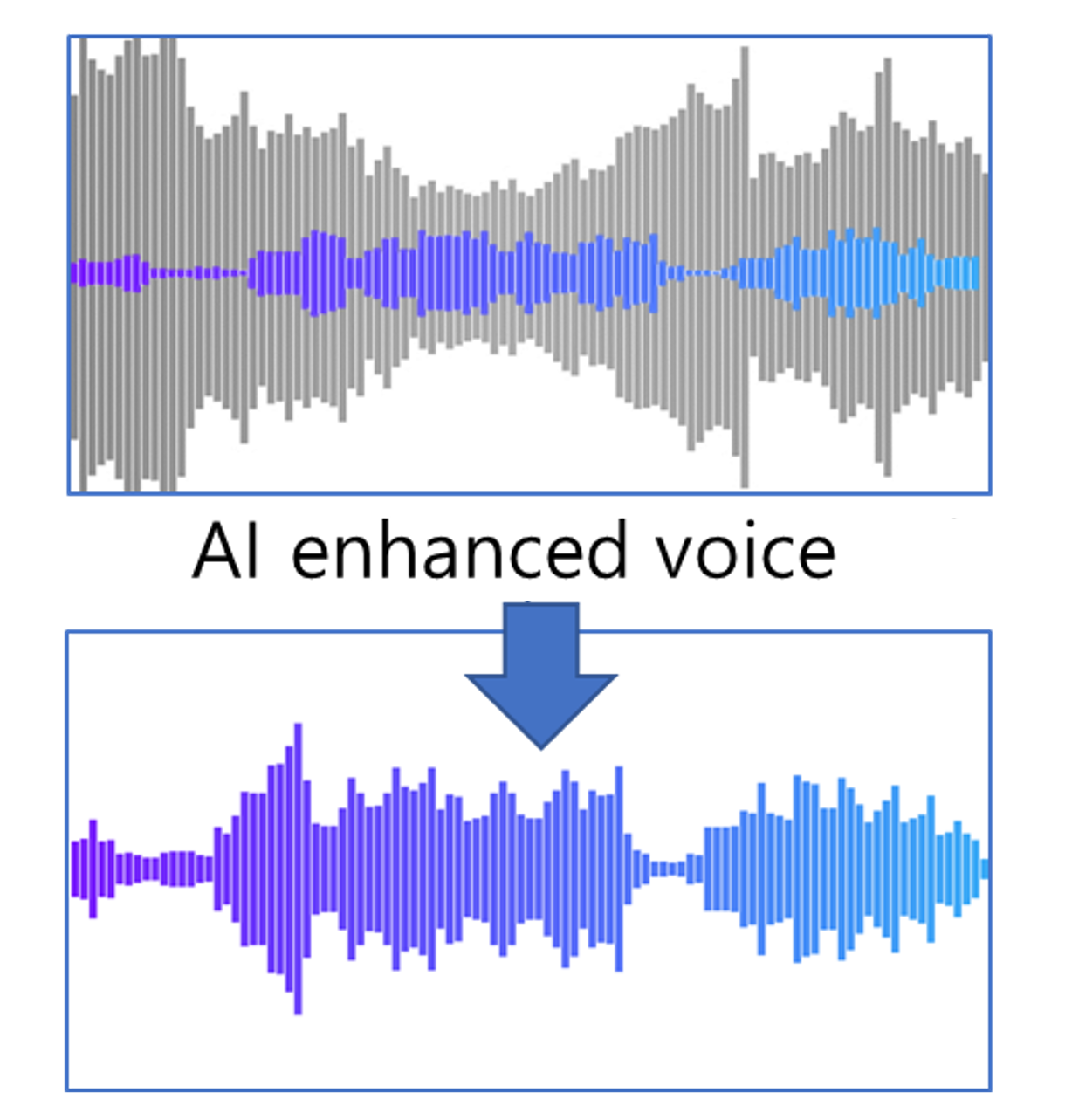 Designed and developed efficient real-time RNN architecture models that distinguish and separate the primary voice from other sounds. The key is to take advantage of Neural Processing Units to achieve optimal sound enhancements in real-time, providing deeper and greater details by analyzing content scene by scene and accentuating various audio elements including human voices, background music and sound effects in next generation products.
Designed and developed efficient real-time RNN architecture models that distinguish and separate the primary voice from other sounds. The key is to take advantage of Neural Processing Units to achieve optimal sound enhancements in real-time, providing deeper and greater details by analyzing content scene by scene and accentuating various audio elements including human voices, background music and sound effects in next generation products.
** Outstanding R&D Award for performance & continuous contributions (12/2023) **
(Results also presented at CES 2024)
Keywords: Deep Neural Networks, Pytorch, Tensorflow, Jax, RNN, Transformers, Speech Processing, Speaker Source Separation, NPU: Neural Processing Units, DSP: Digital Signal Processing Units, Tizen, Real-time Processing
• Face and Speaker Detection & Verification (2022-2023)
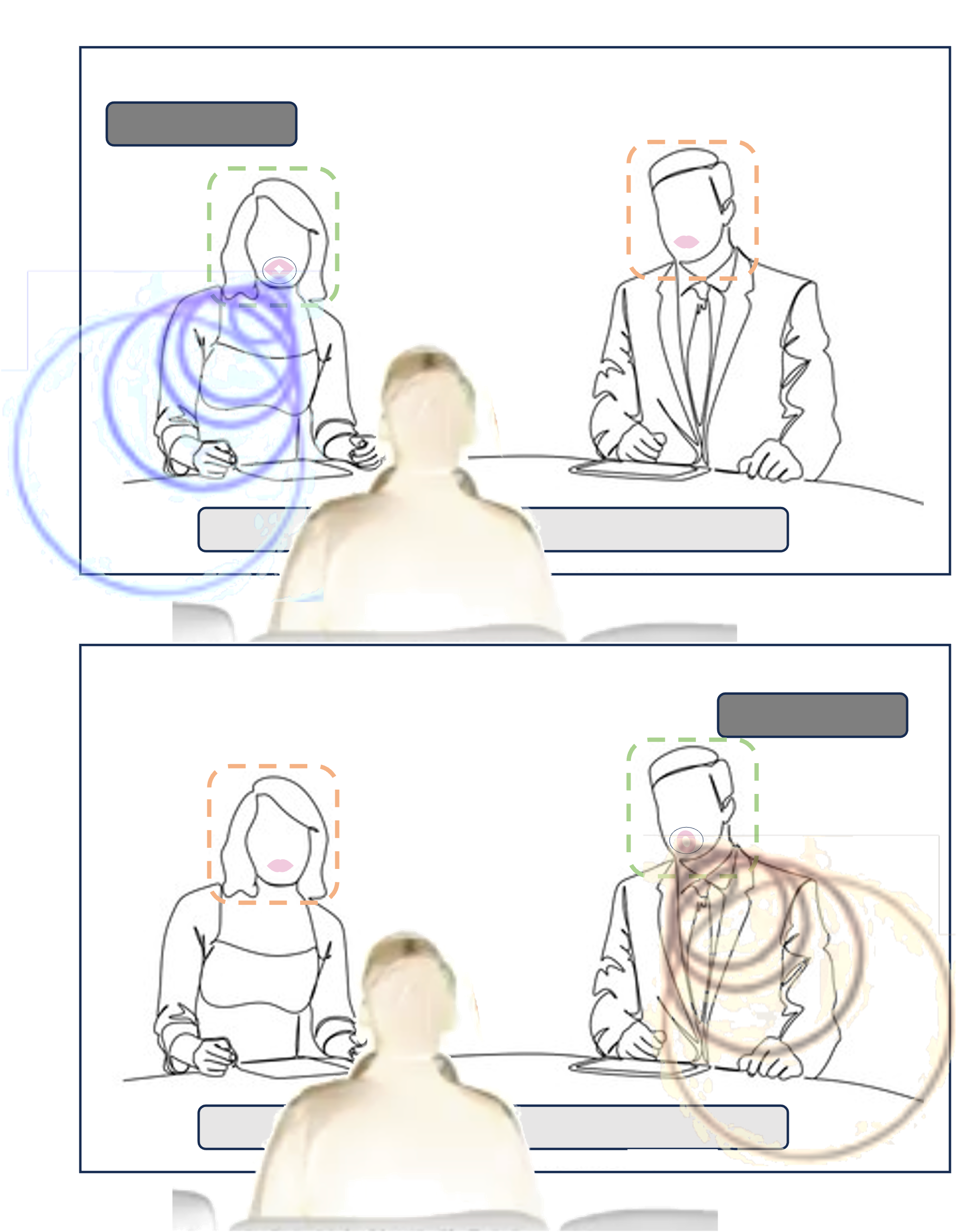 Optimized deep neural network architectures to achieve real-time faces and lips detection, from characters displayed on the screen, taking advantage of Neural Processing Units to automatically associate their voices with their position in the image, for increased realism and immersive sound experience in next generation products. And experimental Speaker Verification for parental control use-cases
Optimized deep neural network architectures to achieve real-time faces and lips detection, from characters displayed on the screen, taking advantage of Neural Processing Units to automatically associate their voices with their position in the image, for increased realism and immersive sound experience in next generation products. And experimental Speaker Verification for parental control use-cases
Keywords: Deep Neural Networks, Pytorch, Tensorflow, Object Detection, NPU: Neural Processing Units, DSP: Digital Signal Processing Units, Tizen, Real-time Processing
Jan.2018-Mar.2022 l Arm
(Machine Learning Group)
Between 2018-2022, as a Principal Engineer in Arm's Machine Learning Group, I worked with David Mansell and Ian Bratt, analysing neural networks of future use-cases, identifying the most relevant operations and data patterns, capturing key insights with data science techniques to advance real-world performance of Arm's new software and hardware solutions.
• Predictive Models for Kernel Selection Heuristics (2020-2022)
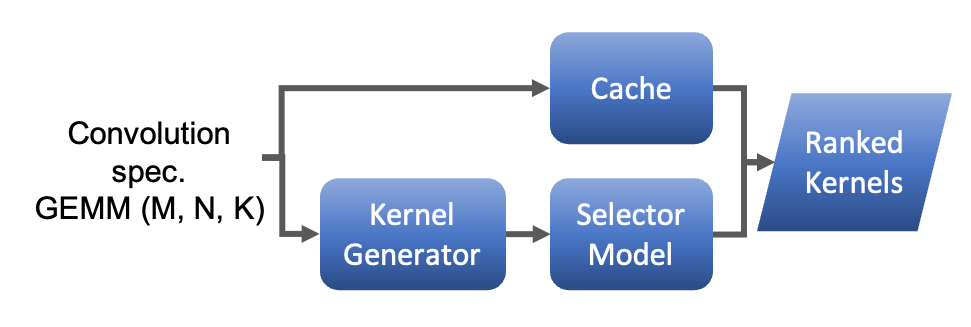 Designed and developed innovative predictive model for CPUs & GPUs, for high-performance selection of kernels implementations of GEMM (General Matrix Multiply) and convolutions, within Machine Learning use-cases; choosing the right implementation in microseconds is crucial through fast and general heuristics.
Designed and developed innovative predictive model for CPUs & GPUs, for high-performance selection of kernels implementations of GEMM (General Matrix Multiply) and convolutions, within Machine Learning use-cases; choosing the right implementation in microseconds is crucial through fast and general heuristics.
Keywords: Deep Neural Networks, Tensorflow, Keras, Convolutions, General Matrix Multiply, Decision Trees, Random Forest, Classification, Regression, AutoML, Data Augmentation, Performance Analysis
• New Armv9-A ML CPU ISA extensions (SME) (2020-2022)
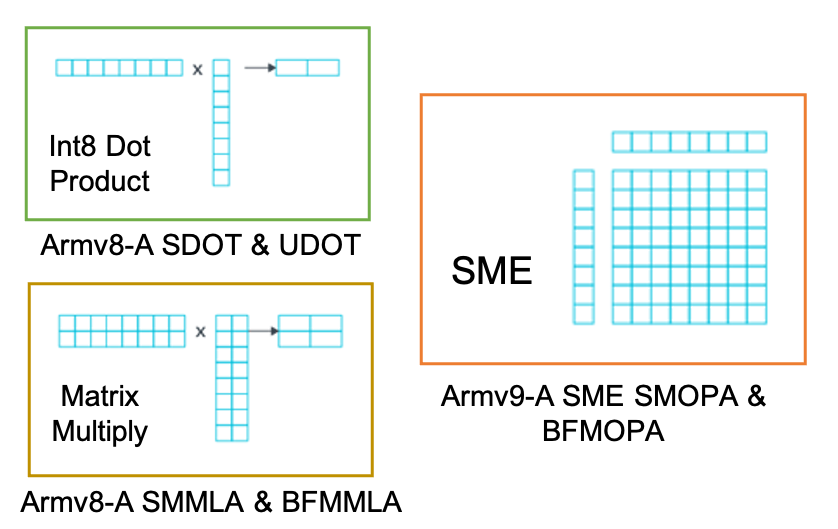 Investigated novel CPU architecture features called SME (Scalable Matrix Extension)—a new instruction set designed to optimize performance and power efficiency of AI applications. SME enables hardware-acceleration of outer product operations, for fast general matrix multiplication used AI core oeprations. Through hardware simulations and benchmarking, I demonstrated to CPU architects and hardware engineers concrete performance gains for AI applications
Investigated novel CPU architecture features called SME (Scalable Matrix Extension)—a new instruction set designed to optimize performance and power efficiency of AI applications. SME enables hardware-acceleration of outer product operations, for fast general matrix multiplication used AI core oeprations. Through hardware simulations and benchmarking, I demonstrated to CPU architects and hardware engineers concrete performance gains for AI applications
Keywords: Matrix multiplication, Outer product, Modelling, CPU Architecture, Deep Neural Network, Performance Analysis
• Future Use-Cases & Deep Neural Networks Performance (2018-2022)
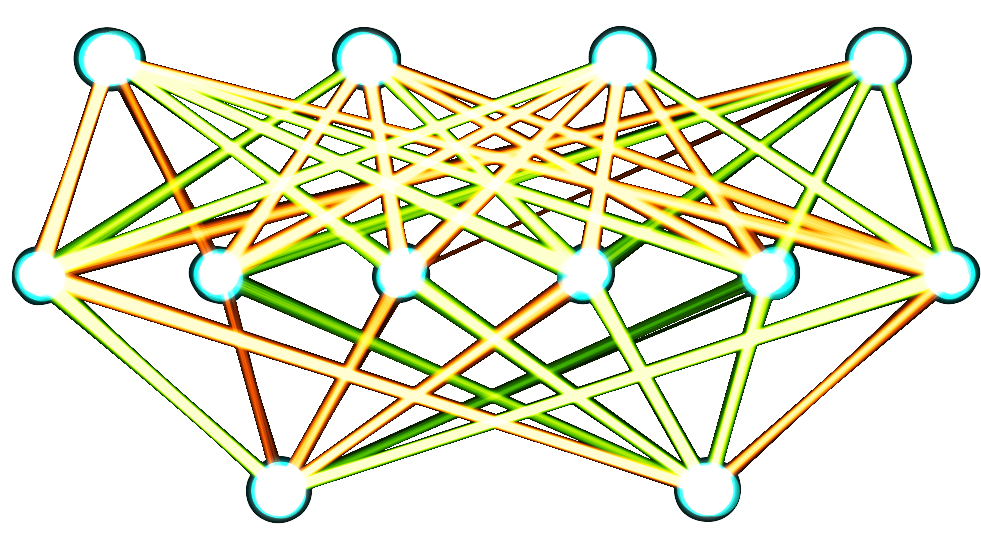 Investigated deep neural networks for future use-cases, analysing them and breaking them down to distill the most relevant operations and data patterns, capturing key insights with data science techniques, to then drive new software and hardware solutions.
Investigated deep neural networks for future use-cases, analysing them and breaking them down to distill the most relevant operations and data patterns, capturing key insights with data science techniques, to then drive new software and hardware solutions.
Keywords: Deep Neural Networks, Convolutions, General Matrix Multiply, Classification, Regression, LSTM, Transformers, Clustering, Ensemble Learning, Data Augmentation, Performance Analysis
Sep.2012-Dec.2017 l Arm
(Architecture & Technology Group)
Between 2015-2017, I worked with Paul Hughes in Arm's Architecture and Technology Group, as member of the Intelligent Machines Future System Design team, analysing and prototyping computer vision and ML subsystems for ADAS.
• ADAS & Computational Biology use-cases (2016-2017)
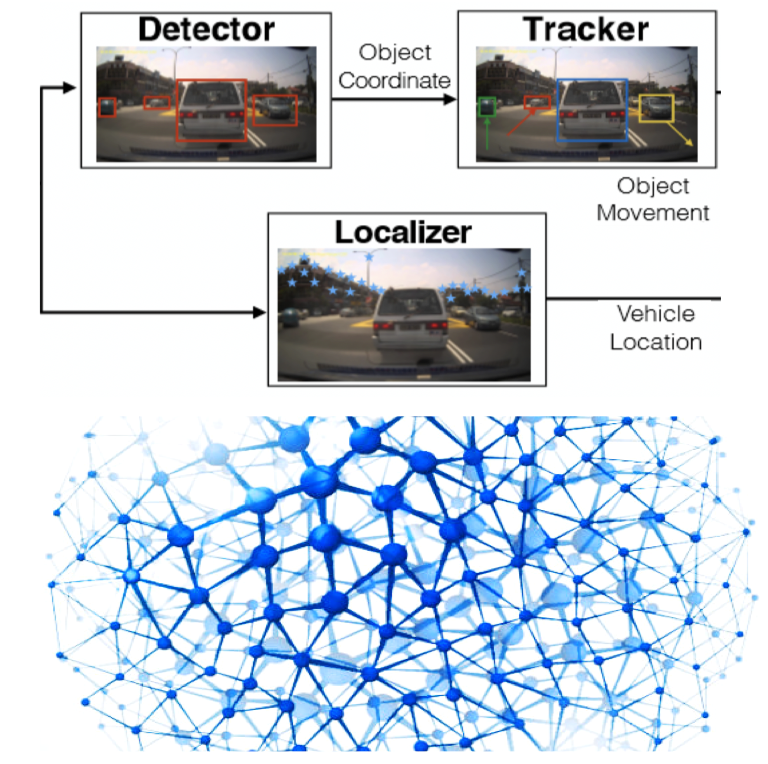 Analysed and prototyped machine learning subsystems for ADAS (Advanced Driver-Assistance System) and Computational Biology applications, to identify which computational patterns could be optimized with the SVE (Scalable Vector Extension) instruction set.
Analysed and prototyped machine learning subsystems for ADAS (Advanced Driver-Assistance System) and Computational Biology applications, to identify which computational patterns could be optimized with the SVE (Scalable Vector Extension) instruction set.
Keywords: Image Segmentation, SLAM, Stereo matching, Object Detection, Graph/Network Structures, Deep Neural Networks, System Architecture, Memory management, Virtualization, Software Modelling, Performance Analysis
• New Armv8-A CPU ISA extensions (SVE) (2015-2016)
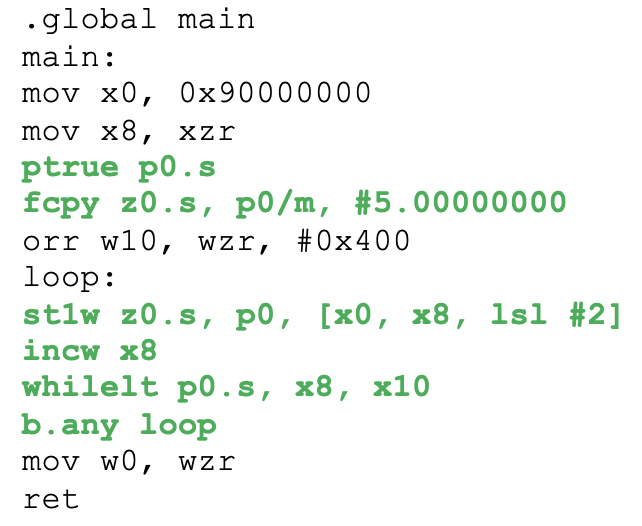 Investigated the impact of SVE (Scalable Vector Extension): a new instruction set, with applications in computer vision workloads, exploiting as much data-level parallelism as possible, with new instructions and vector lengths that scale from 128 to 2048 bits. Through hardware simulations and benchmarking, I demonstrated to CPU architects and hardware engineers concrete performance gains in computer vision applications.
Investigated the impact of SVE (Scalable Vector Extension): a new instruction set, with applications in computer vision workloads, exploiting as much data-level parallelism as possible, with new instructions and vector lengths that scale from 128 to 2048 bits. Through hardware simulations and benchmarking, I demonstrated to CPU architects and hardware engineers concrete performance gains in computer vision applications.
Keywords: Single Instruction, Multiple Data (SIMD) programming model, Vector Instructions, Parallel Programming, Modelling, CPU Architecture, Computer Vision, Keypoint and Features Detection, Assembly Language, Performance Analysis
Between 2012-2014, I joined Arm's Processor Division as Staff Engineer, working on system architecture and heterogeneous computing projects with Charles Garcia-Tobin and Jason Parker.
• Heterogeneous Computing and GPU Coherency (2012-2014)
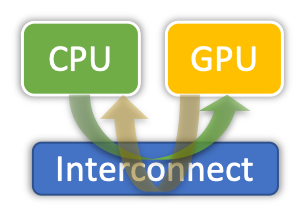 Modelled and prototyped low-level software, and analysed heterogeneous compute use-cases to incorporate Shared Virtual Memory (SVM) support between different type of processors (CPU & GPU), enabling them to share data, as simply as passing a pointer, which massively simplify the software, and delivers more power efficient and higher performance applications than other software managed cache synchronization mechanisms.
Modelled and prototyped low-level software, and analysed heterogeneous compute use-cases to incorporate Shared Virtual Memory (SVM) support between different type of processors (CPU & GPU), enabling them to share data, as simply as passing a pointer, which massively simplify the software, and delivers more power efficient and higher performance applications than other software managed cache synchronization mechanisms.
Keywords: Memory Models, Cache Memory, Interconnect, Heterogeneous Computing, System Architecture, Modelling, System Programming, Simulation Waveform, FPGA prototyping
Personal Projects l
Honors and awards l
2023 Samsung Electronics:
Outstanding R&D Award for performance & continuous contributions [Dec. 2023]
2021 University of Girona:
Interview & career recognition [book release: Nov. 2021]
Career recognition by the board of trustees of the Polytechnic School Patronage (University of Girona) in 25th anniversary book, by founding members, industrialists, representatives of institutions, Chamber of Commerce, delegates from different government departments and presidents and deans of professional associations from University of Girona. 25th Anniversary Book: Polytechnic School Patronage
2013 Best Ph.D. Thesis Award of the School of Computer Science
Parallel spatial data structures for interactive rendering, PhD Thesis, defended October 2012
Publication September 2013
University of Girona
2007 Best Computer Science Project Award
Generation and real-time visualization of 3D vegetation
University of Girona, Spain
Patronat Award 12th Edition winner
Supervised by Dr. Gustavo Patow and Prof. Mateu Sbert
Technical skills l
Languages l
English (Read, Write and Speak: Fluent), Spanish (mother language), Catalan (Read, Write and Speak: Fluent), Korean (Beginner).
Programming Languages l
Python, C, C++, Objective C, OpenCL, CUDA, Aarch64 Assembly (NEON, SVE), Javascript, R, Latex, MatLab, HLSL, GLSL, SQL, NoSQL, HTML, CSS, PHP.
Programming frameworks, tools and APIs l
Tensorflow, Pytorch, JAX, AirFlow, RStudio, Mathematica, Github Copilot, Jupyter Notebook, Caffe2, OpenCV, DirectX, OpenGL, OpenMP, Unity, Android NDK, LLVM, AWS (EC2, EFS, S3), Google Cloud Platform, Docker, Kubernetes, Spark, Hadoop, Git, Confluence, JIRA, Sharepoint, Visual Studio, GDB, 3ds Max, Maya, Zbrush, Blender, Photoshop, Gimp, Inkscape.
Full-Stack Development l
OSX, Linux, Android, Tizen, Windows, Firmware and bare-metal.
Keywords: parallel computing, multi-threaded design, algorithm design, numerical methods, data visualization, machine learning, computer vision, 3d graphics and game engine programming, white papers, technical papers, GPU, CPU and FPGA development
Education and training l
Ph.D. in Computer Science
Dissertation: Parallel spatial data structures for interactive rendering
BR PhD Fellowship from the University of Girona
Master in Computing
From the University of Girona, and the UPC Barcelona Tech
Computer Engineering
University of Girona, Spain
Academic research l
Selected Research Publications l
I have a Ph. D. in Computer Science from University of Girona. My research concerned with parallel efficient data structures for data visualization, geometric modeling, image-based representations and ray-tracing.
My previous research explored practical applications in a variety of areas in computer graphics, including real-time rendering, GPU efficient data-structures for geometry processing and texturing, and dynamic parallel data-structures for ray-tracing and general-purpose GPU applications.
• Parallel spatial data structures for interactive rendering (2013)
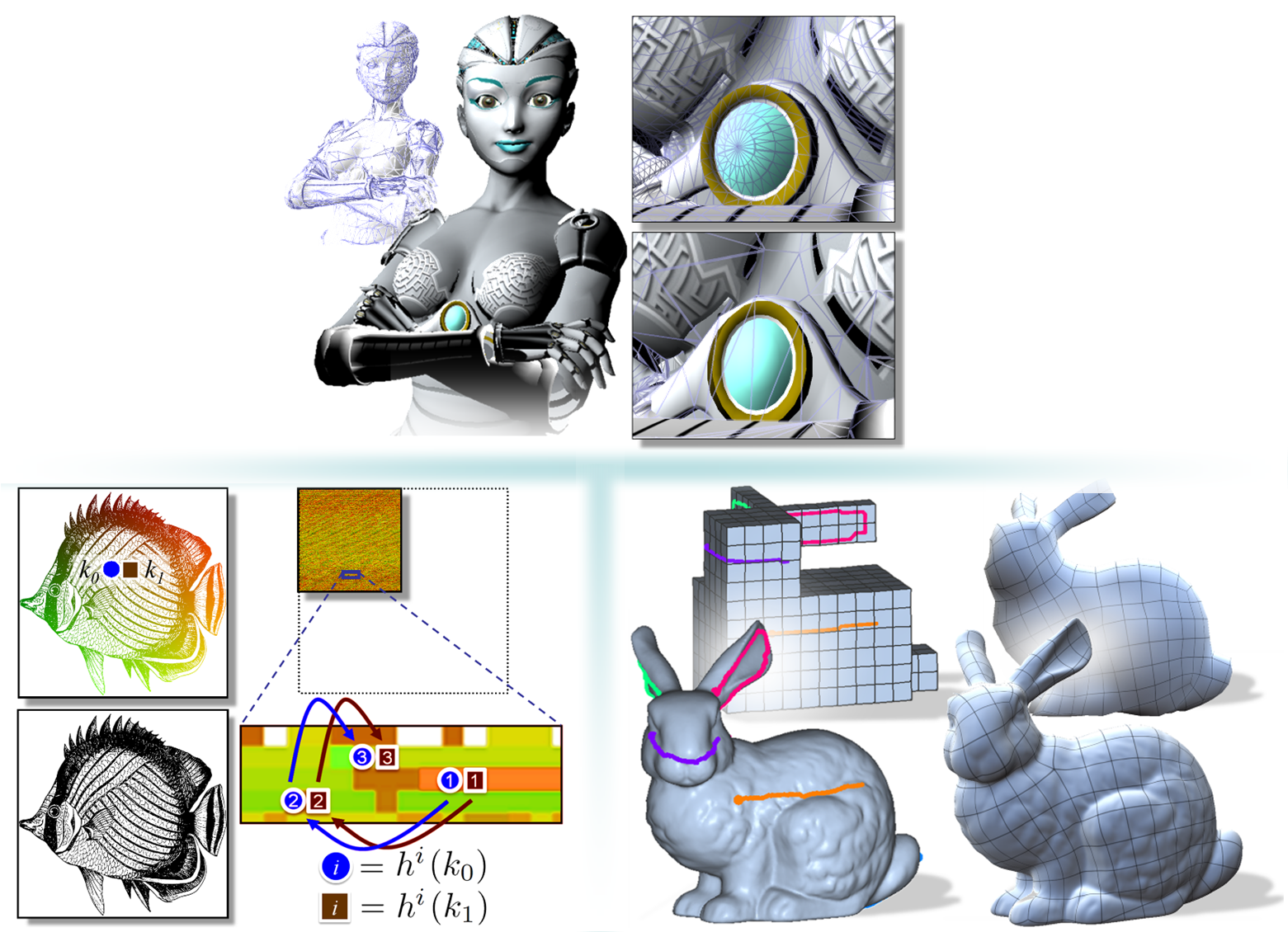 PhD Thesis, defended October 2012 [pdf]
(Best Ph.D. Thesis Award, School of Computer Science 2013
University of Girona
)
PhD Thesis, defended October 2012 [pdf]
(Best Ph.D. Thesis Award, School of Computer Science 2013
University of Girona
)
Keywords: Spatial data, Dense and Sparse Data Structures, Parallel Computing, Spatial Hashing, Surface Parameterization, Subdivision Surfaces, Surface Simplification
• Interactive Applications for Sketch-Based Editable Polycube Map (2013)
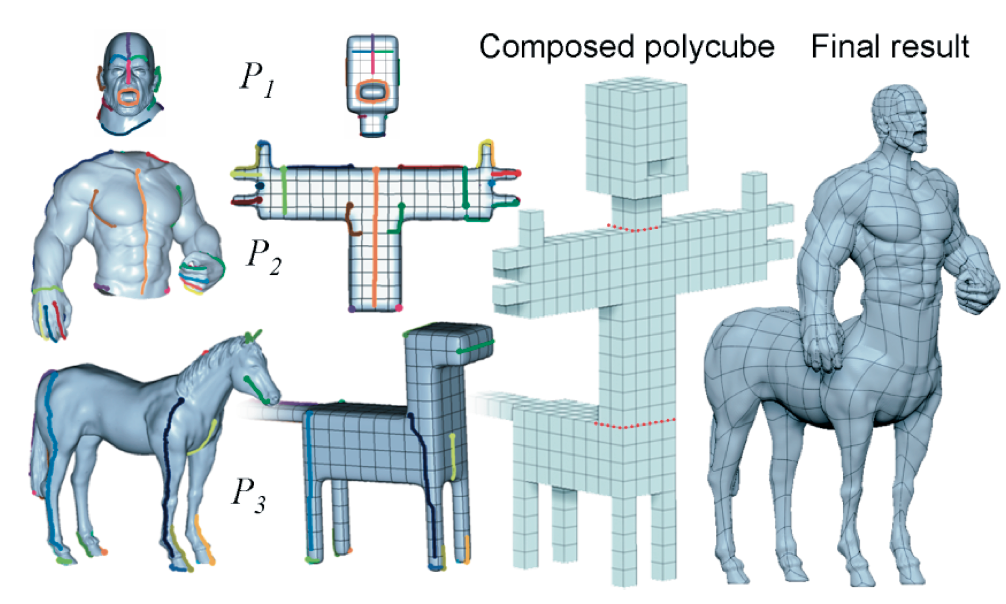 IEEE Transactions on Visualization and Computer Graphics, (Volume:19, Issue: 7, July 2013); Ismael Garcia, Jiazhi Xia, Ying He, Shi-Qing Xin, Gustavo Patow [pdf]
IEEE Transactions on Visualization and Computer Graphics, (Volume:19, Issue: 7, July 2013); Ismael Garcia, Jiazhi Xia, Ying He, Shi-Qing Xin, Gustavo Patow [pdf]
Keywords: Digital Geometry Processing, Surface Parameterization, Polycube Map, GPU Subdivision Surface
• A Runtime Cache for Interactive Procedural Modeling (2012)
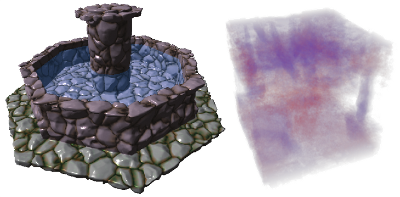 SMI 2012: Shape Modeling International, Computer & Graphics; Tim Reiner, Sylvain Lefebvre, Lorenz Diener, Ismael Garcia, Bruno Jobard, Carsten Dachsbacher [project page]
SMI 2012: Shape Modeling International, Computer & Graphics; Tim Reiner, Sylvain Lefebvre, Lorenz Diener, Ismael Garcia, Bruno Jobard, Carsten Dachsbacher [project page]
Keywords: Parallel Hashing, Runtime Cache, Interactive Shape Modeling, Implicit Surface Rendering, Procedural Textures
• Coherent parallel hashing (2011)
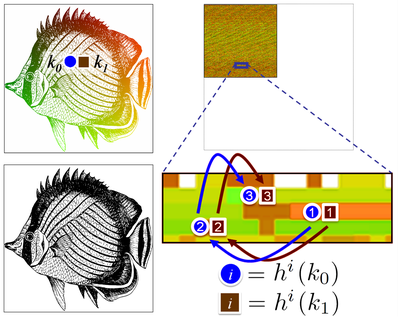 ACM Transactions on Graphics, Proceedings of SIGGRAPH Asia, Vol. 30(6), 2011, Ismael Garcia, Sylvain Lefebvre, Samuel Hornus, Anass Lasram [project page]
ACM Transactions on Graphics, Proceedings of SIGGRAPH Asia, Vol. 30(6), 2011, Ismael Garcia, Sylvain Lefebvre, Samuel Hornus, Anass Lasram [project page]
Keywords: Spatial Data, Parallel Computing, Coherent Memory, Cache Memory, Hashing, Sparse Data
• Editable Polycube Map for GPU-based Subdivision Surfaces (2011)
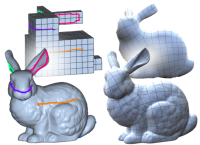 I3D 2011: Proceedings of Symposium on Interactive 3D Graphics & Games; Jiazhi Xia, Ismael Garcia, Ying He, Shi-Qing Xin, Gustavo Patow [project page]
I3D 2011: Proceedings of Symposium on Interactive 3D Graphics & Games; Jiazhi Xia, Ismael Garcia, Ying He, Shi-Qing Xin, Gustavo Patow [project page]
Keywords: Digital Geometry Processing, Surface Parameterization, Polycube Map, GPU Subdivision Surface
• IGT: Inverse Geometric Textures (2008)
 ACM Transactions on Graphics, Proceedings of SIGGRAPH Asia, Vol. 27(5), 2008; Ismael Garcia, Gustavo Patow
[project page]
ACM Transactions on Graphics, Proceedings of SIGGRAPH Asia, Vol. 27(5), 2008; Ismael Garcia, Gustavo Patow
[project page]
Keywords: Appearance Preserving Simplification, Detail-Recovery, Computer Games, Texturing, Parameterizations, Level-of-Detail
Selected Undergraduate Research Publications l
I was introduced in the Computer Graphics field advised by Prof. Mateu Sbert. In 2005 I did a research internship collaborating with Prof. Laszlo Szirmay-Kalos at Technical University of Budapest Computer Graphics Research Group. In 2007 I started my Phd. in Computer Graphics joining the GGG research group, under the supervision of Dr. Gustavo Patow with doctorate research internships with ALICE Project-Team (INRIA Nancy), collaborating with Dr. Sylvain Lefebrve.
• Generation & interactive visualization of 3D vegetation (2007)
 Master thesis in Computing, 2007; from the University of Girona and the UPC Barcelona Tech; advised by Dr. Gustavo Patow and Prof. Mateu Sbert [pdf]
Master thesis in Computing, 2007; from the University of Girona and the UPC Barcelona Tech; advised by Dr. Gustavo Patow and Prof. Mateu Sbert [pdf]
• Multi-layered indirect texturing for tree rendering (2007)
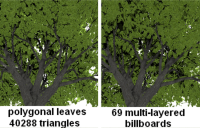 Eurographics Workshop on Natural Phenomena 2007; Ismael Garcia, Gustavo Patow, Laszlo Szirmay-Kalos, Mateu Sbert
[project page]
Eurographics Workshop on Natural Phenomena 2007; Ismael Garcia, Gustavo Patow, Laszlo Szirmay-Kalos, Mateu Sbert
[project page]
Keywords: Image Generation, Clustering, 3D Graphics, Realism
• Leaf cluster impostors for tree rendering with parallax (2005)
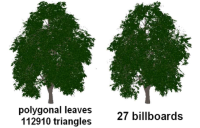 Short Paper of Eurographics (Dublin, Ireland), pp. 69-72, 2005; Ismael Garcia, Mateu Sbert, Laszlo Szirmay-Kalos
Short Paper of Eurographics (Dublin, Ireland), pp. 69-72, 2005; Ismael Garcia, Mateu Sbert, Laszlo Szirmay-Kalos
Keywords: Image Generation, Clustering, 3D Graphics, Realism
Academic teaching l
From 2010 to 2011 Multimedia and computing technologies,
Technical Computer Engineering (University of Girona)
Teaching assistant
From 2009 to 2010 Multimedia and computing technologies,
Technical Computer Engineering (University of Girona)
Teaching assistant
From 2008 to 2009 Information Technologies,
Enviromental Science (University of Girona)
Teaching assistant
From 2007 to 2008 Effective audio-visual presentations,
Law (University of Girona)
Teaching assistant
From 2007 to 2008 Information Technologies,
Enviromental Science (University of Girona)
Teaching assistant
Conference talks l
2021: Modelling Machine Learning networks with Scalable Matrix Extensions
Global Engineering Conference
Arm internal engineering conference
2019: Data-driven analytics to advance Arm ML-solutions
Global Engineering Conference
Arm internal engineering conference
2018: Improving ML solutions with Data Science
Data + Insights
Arm internal Data Science Conference
2011: Event Lab Talk
Parallel computing for data processing, rendering & interaction
Event Lab Invited Speaker
University of Barcelona
Barcelona, Spain
2011: Coherent parallel hashing
SIGGRAPH Asia 2011
Hong Kong, China
2011: Editable Polycube Map for GPU-based Subdivision Surfaces
Symposium on Interactive 3D Graphics and Games 2011
San Francisco, USA
2008: IGT: Inverse Geometric Textures
SIGGRAPH Asia 2011
Singapure, Singapore
2007: Multi-layered indirect texturing for tree rendering
Eurographics Workshop on Natural Phenomena 2007
Prague, Czech Republic
2005: Leaf cluster impostors for tree rendering with parallax
Eurographics 2005
Dublin, Ireland
Supervised Bachelor Students: l
2017 Gershom Akoli Agim
Deep Neural Networks on Arm Cortex-A CPUs: Analysis of CPU Inference on Vision workloads
MEng Electrical & Electronic Engineering Hons Project
Heriot-Watt University, United Kingdom
2016 Jan-Peter Larsson
3D Reconstruction using Stereo Matching Techniques on Scalable Vector Processors
MEng Electrical Hons Project
Edinburgh University, United Kingdom
2011 Enrique Nuzete
Interactive polycubemap editor
BEng Project, Technical Computer Engineering
University of Girona, Spain
2011 Tania Mendes
Modelling and visualization of skeleton-based animations
BEng Project, Technical Computer Engineering
University of Girona, Spain
2007 Verena Skuk
Procedural modelling and rendering of vegetation
Student Research Project
University of Girona, Spain
2007 Isaac Moles
Real-time rendering of large forest
BEng Project, Technical Computer Engineering
University of Girona, Spain
Other professional activities l
Program Committee Member l
CGVCVIP Computer Graphics, Visualization, Computer Vision & Image Processing
2012
IADIS International Conference Computer Graphics Visualization and Image Processing
Journal program committee member
CEIG:
CEIG 2015
Conference program committee member
Reviewer l
Siggraph Asia:
Siggraph Asia 2015
Technical papers reviewer
Siggraph Asia 2014
Technical papers reviewer
CGI Computer Graphics International:
CGI 2012
Technical papers reviewer
I3D Interactive 3D Graphics and Games:
I3D 2012
Technical papers reviewer
EG Eurographics:
EG 2013
Technical papers reviewer
EG 2008
Technical papers reviewer
Computer Animation and Virtual Worlds Journal:
2014 Computer Animation and Virtual Worlds Journal
Technical papers reviewer
CEIG Congreso Español de Informática Gráfica:
2015 CEIG 2015
Technical papers reviewer
2009 CEIG 2009
Technical papers reviewer
2008 CEIG 2008
Technical papers reviewer
Conference Organizer l
2009 Eurographics Symposium on Rendering, EGSR
Girona, Spain
Local organizer
Industry research collaborations l
2010 GPU Mesh Processing tools
NVIDIA Mutual Non-Disclosure Agreement
Academic undergraduate experience
From June 2011 to December 2013 Advances in virtual reality for cutting edge applications
Spanish Ministry of Science and Technology Project (TIN2010-20590-C02-02)
Research developer
From November 2007 to July 2010 CALBaD: Computer Aided Light Based Design
Spanish Ministry of Science and Technology Project (TIN2007-67120)
Research developer
From October 2009 to December 2009 Research intership - INRIA Nancy (France), Alice project-team
Phd thesis research intership under supervision of Dr.Sylvain Lefebvre
Mobility grant TME2008-00961 from Alice project-team
INRIA Nancy France
Reserch developer
From May 2007 to May 2011 PhD research fellowship BR
University of Girona
Research PhD student
From September 2004 to April 2007 Gametools Project
European Union Project (IST-2-004363)
Research developer
From February 2010 to April 2010 Research intership - INRIA Nancy (France), Alice project-team
Phd thesis research intership under supervision of Dr.Sylvain Lefebvre, INRIA contract Alice project-team
INRIA Nancy, France
Research developer
From February 2005 to May 2005 Research undergraduate intership
Undergraduate final project under supervision of Prof.László Szirmay-Kalos
Technical University of Budapest
Erasmus programme grant
Research developer
From June 2003 to March 2006 El Baúl S.A. – Grupo editorial el baúl
Redesign and implementation of online classified advertisement and community website.
elbaul.com
Web developer
From July 2002 to December 2002 Institut d’Informàtica i Aplicacions, Universitat de Girona
Review and performance analysis of of the Sony’s Playstation 2 Linux Development Kit.
Project number TIC2001-2416-C03-01, financed by the Spanish Ministery of Science and Technology
[pdf]
Software developer
From June 2000 to September 2000 Igm Web S.L.
Design and implementation of several corporative websites.
Igm Web S.L.
Web developer
From June 1999 to September 1999 Kripton Networks
Writing technical reviews of videogames as a freelance web journalist.
Iespana/Informatica
Web technical writer
